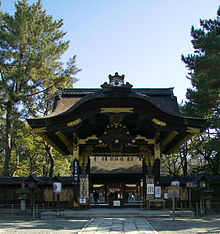|
Toyokuni Shrine (Kyoto)
Toyokuni Shrine (豊国神社, Toyokuni-jinja) is a Shinto shrine located in Higashiyama-ku, Kyoto, Japan. It was built in 1599 to commemorate Toyotomi Hideyoshi. It is the location of the first tamaya (a Shinto altar for ancestor worship) ever constructed, which was later destroyed by the Tokugawa clan.[1] HistoryThis shrine is the official tomb and shrine of Toyotomi Hideyoshi, who died on September 18, 1598, in Kyoto.[2] Nobles, priests, warriors, and townspeople gathered at the shrine to celebrate the anniversary of Hideyoshi's apotheosis with banquets, musical recitals, and boisterous festivity. The shrine was closed by Tokugawa Ieyasu in June 1615 "to discourage these unseemly displays of loyalty to a man he had eclipsed."[3] The Meiji Emperor directed that the shrine be restored in Keiō 4, the 6th day of the 6th month (April 28, 1868).[4] At that time, the shrine area was expanded slightly by encompassing a small parcel of land which had been part of the adjacent Hōkō-ji.[5] In 1897, the tercentenary of Hideyoshi was celebrated at this site.[6] ArchitectureIt is generally believed that the karamon gate was originally built for Hideyoshi's Fushimi castle in 1598.[7] When the castle was dismantled in 1623, the gate was first moved to Nijō castle,[8] and then to the Konchi-in in Nanzen-ji. It was finally relocated to Toyokuni shrine in 1876 after the Meiji Restoration.[9] Designated Cultural PropertiesNational Treasures of Japan
Important Cultural Properties
Gallery
See also
Notes
ReferencesWikimedia Commons has media related to Toyokuni Shrine (Kyoto).
|
||||||||||||||||||||||||





